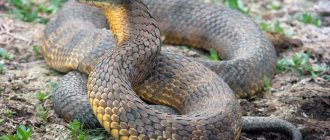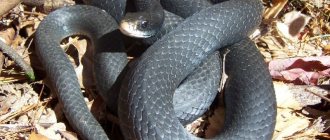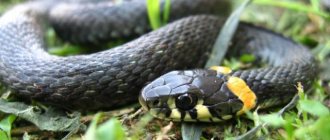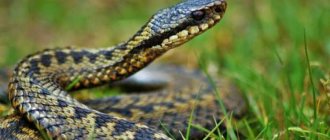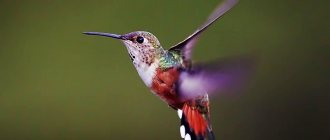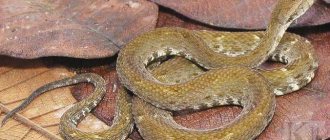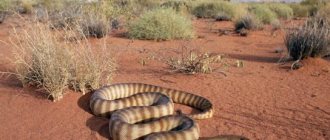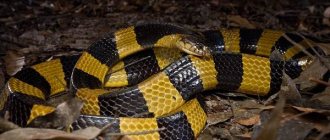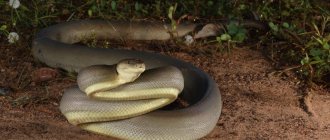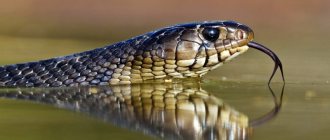The self-isolation regime eased, and Sochi residents rushed to breathe the air of freedom and headed out into nature: some to the dacha, some to the sea, and most to the mountains.
And you can meet THEM everywhere...
Snakes of Greater Sochi.
In recent years, the city has experienced hot, dry summers. And the number of reptiles has increased. But it's not all that scary. Let's figure out which snakes and where can you meet in Sochi?
Our expert: Elena Chaika, Sochi Turisto club @sochi_turisto
If we take the territory of the Sochi National Park, from the border with the Tuapse region to the border with Abkhazia you can find the following snakes.
Olive snake
A rare Mediterranean species, one of the most graceful and swift Sochi snakes. The length rarely exceeds one meter. A small head with very large and, as it seemed to us, intelligent eyes. The body color is olive, light brown, very similar to a watering hose. There are always light vertical stripes in front and behind the eyes. The belly is yellowish or greenish-white.
The olive snake not only prefers sunny places, but will also be happy to meet you among wet ferns. In the mountains it is found up to an altitude of 2200 meters.
This snake is much less aggressive than its brothers. He doesn’t hiss, doesn’t attack, and when there is danger, he will always run away first. The snake does not make any sounds at all; it is called a silent snake. If you catch a snake, it can bite, and quite painfully, since it has sharp and thin teeth. But the snake has no poison; this bite will not cause harm to humans.
Anacondas
The largest snake in nature is the anaconda.
Giant anaconda.
Again, scientifically speaking, anacondas are a genus of snakes consisting of several species. And the largest species of snake is the giant anaconda, the photo of which you see above.
Giant anaconda.
The largest giant anaconda caught weighed 97.5 kg with a length of 5.2 meters. This snake was caught in the wild jungle in Venezuela. Residents of remote villages claim that they have seen larger anacondas, but there is no evidence of the existence of larger specimens.
Aesculapian snake
As graceful as olive. It is this snake that is depicted on the medical emblem.
The Aesculapian snake is more often found in the Lazarevsky district, in the valley of the Ashe and Dagomys rivers. In mixed forests and foothills no higher than 2000m above sea level. You can often find this snake in trees. This snake is not aggressive; when it meets a person, it slowly crawls away or freezes in place, watching him.
The snake is harmless and suffers from a person who unknowingly destroys these animals. In addition, this snake benefits nature by destroying small rodents.
Unfortunately, the species has now become rare and is listed in the Red Books of the Russian Federation, Krasnodar Territory, and the Republic of Adygea.
The most dangerous snakes in Russia
About 40 species of snakes live on the territory of the Russian Federation. About 11 of them can be called truly dangerous. Comfortable conditions for the existence of snakes have developed only in the southern regions of the country, so the largest number of species have accumulated there.
Some species of snakes living in Russia pose a real danger to human life
Gyurza is the most poisonous snake in Russia
The venom of the viper is fatal; it itself exhibits aggressive behavior and a tendency to camouflage.
If we multiply this by large sizes, we get extreme danger. Found in the mountainous and foothill regions of the Caucasus and Dagestan. The length of the snake reaches 1.5-2 m. It has a powerful muscular body, a triangular head and a rounded muzzle. There are scales above the eyes. The color of the scales is brown, red-brown, gray, blue-black. The scales on the head are rough.
Gyurza hides well, so you may not notice it when you meet it. If you step on it, the attack is guaranteed, and sudden and fast. The length of the jump is equal to the length of the snake's body. She will never run away from a person when she meets him, and can attack even if there is no threat to her life.
The viper is the most dangerous snake; its bite is often fatal
In November, the viper goes into hibernation to wait out the cold season. In March-April, when the air temperature reaches +10 °C, it wakes up. At first, she is in no hurry to crawl away from her hibernation site; she basks in the sun for a long period. In May, she goes to lakes or rivers, where she hunts and drinks a lot of water. In hot weather, she begins to hunt at night. Due to its excellent sense of smell and vision, it can navigate well in the dark.
Common viper
There is hardly a more famous venomous snake than the viper. People are rightly wary of it, as they have heard about its deadly poison. It has a widespread habitat: it is found throughout Russia, including the Central Zone, Siberia, and the eastern part of the country.
The viper is not a large species of snake, since its length reaches only 75 cm. The color of the scales can be different: black, brown, gray. The head shape is triangular.
The common viper is the most common venomous snake and is found almost throughout Russia.
The viper has an excellent sense of smell, thanks to which it is sensitive to danger. At the same time, vision is not very good and allows you to see no further than two meters.
In May, vipers begin to crawl out of their hiding places and attract people's attention. Most often they can be found near stones, stumps, hummocks, on paths and near roads. These snakes live in swamps, near natural reservoirs, and in forests.
The active period ends in September. In most cases, the viper will prefer to avoid the person who is nearby. They usually attack only if they see a clear threat to their lives.
Steppe viper
The steppe viper is not as common as the common viper, but it is also quite common. It is found in the northern part of Russia, in the southern part of the West Siberian region.
The snake differs from its sister in smaller size - the body length reaches only 60 cm. There are sometimes spotted spots on the upper part of the body. In winter, snakes of this species hibernate, which lasts until the end of March, until the temperature rises above +6 °C. They have the ability to swim quickly and climb trees, while on the ground they move much more slowly.
The steppe viper lives in the steppe regions of southern Russia
The name of the steppe viper was chosen due to its love of open landscapes. Snakes are found in large concentrations in meadows, rocky areas, and on the shores of lakes.
Caucasian viper and Dinnika's viper
The Caucasian viper, as the name suggests, is native to the North Caucasus and Georgia. It is quite rare in nature, has a not too dangerous poison and a beautiful color. It is often kept in terrariums.
The viper reaches a length of 60 cm. It has colorful scales: orange-black, brick, lemon. After molting, the scales become even more saturated. As we age, color boundaries blur.
Despite the fact that the venom of the Caucasian viper is not fatal and will not cause serious damage to health, you will still have to deal with the consequences of the bite. The snake is relatively peaceful, and attacks only in case of danger or capture of prey. If the victim resists, the poison is released.
The Caucasian viper is a poisonous snake whose bite can cause serious health problems
In recent years, the population of this viper species has declined even further. There are several reasons for this: rare laying of eggs (once a year), frequent falling under the wheels of cars, and capture for keeping in artificial conditions.
Dinnika's viper lives in the vast Caucasus, occupying the northern and southern slopes of the mountains. She loves areas covered with mosses and lichens, overgrown with moraine and thyme. Dinnika's viper looks like a half-meter snake with a zigzag dark stripe along the entire length of its body. There are vertical dark stripes on the sides. The main color can be yellow, orange or black. The wide and flat head is clearly separated from the body. Females of this species are larger than males. Dinnik's vipers are most active in the morning. In inclement weather they like to crawl out of shelters during the daytime. The diet is normal for a snake: it includes rodents, lizards, and birds.
The hemolytic venom of the viper destroys red blood cells.
Dinnika's viper lives on forested mountain slopes and rocky screes.
Cottonmouth
The snake has shields on its head, due to which it received its name. The range extends from the Lower Volga region to the Far East. It is also common in Iran, Monoglia and the Caucasus.
The copperhead is longer than the viper, its size usually reaches 85 cm. Moreover, it has a relatively flat body. Most often there are representatives with a dull color, brown or gray-olive, but occasionally you come across conspicuous orange individuals. The scales have transverse dark stripes.
Under the eyes of the snake there is a heat-sensitive hole that captures the heat emanating from the body of the prey. This feature distinguishes the copperhead from other species of snakes.
The cottonmouth is a poisonous reptile, the distinctive features of which are the scutes on the top of the head.
In central Russia, hibernation for the copperhead begins in October and lasts throughout the cold season. During the mating season, which comes after wintering, males show strong aggression. After injecting the poison, a person’s temperature rises, and a hematoma forms at the site of the bite. The unpleasant consequences disappear in about a week.
Ordinary
Another name is Pallas's muzzle. Often found in towns and landfills. Distributed in Transbaikalia, Southern Siberia, Rostov region.
Stone
Likes to crawl into logging areas. Lives in Primorye, Kuanshir, Amur Region and Khabarovsk Territory.
Common cottonmouth
Stone muzzle
Ussuri Cottonmouth
Ussuri
The smallest representative of cottonmouths. The habitat is similar to that of the stone muzzle. Reaches no more than 68 cm. The bite is painful, but not fatal.
Tiger snake
Lives in Primorsky and Khabarovsk territories. Prefers humid regions filled with swamps, rivers and lakes, but sometimes settles in dry areas.
The tiger snake reaches one meter in length. The most common color of the body is green; there are also blue, brown, and black snakes.
It is distinguished by large eyes with round pupils. On the sides of the head there is a characteristic pattern of two black spots.
The tiger snake is a Far Eastern snake that lives in wooded areas closer to water
Sensing danger, the tiger snake assumes a vertical position, like a cobra, and begins to hiss. If a predator at this moment grabs him by the neck, he stumbles upon the poisonous glands, so he quickly releases the snake. At the same time, a snake bite is low-risk, since the teeth are already hidden in the depths of the pharynx and, moreover, bend inward.
Yellowbelly
Despite their innocuous name, yellowbellies are quite aggressive snakes. When they encounter danger, they begin to hiss desperately, trying to scare away the victim, and often attack even without obvious danger. They live in the Ciscaucasia and Lower Volga region.
The yellowbelly is a large snake with an aggressive nature.
A person may find a yellowbell in his garden, haystack or ruins, where it is likely to attack him. If the prey tries to escape, the snake may give chase, whether human or horse. It crawls at high speed and can move quickly through trees. Despite their increased aggressiveness, yellowbellies are not poisonous, but a bite from their teeth can seriously injure a person or animal.
This is the largest European snake, the size of which reaches 2.5 m. The top of the snake is gray, olive, brown or black, the bottom is yellow. She loves dry places, so she chose steppe, desert and rocky areas.
Multi-colored snake
Lives in the North Caucasus. He likes to live in attics, in gardens, on roofs. Has a tendency towards aggression; when meeting a person, it is highly likely to hiss and try to attack. When toxic saliva enters the bloodstream, it causes poisoning, which resolves within 2-4 days.
The multi-colored snake is a non-venomous aggressive snake with toxic saliva
Lizard snake
Lives in Kalmykia, Astrakhan region and Stavropol region. This is one of the most harmless and safe snakes in Russia. She is devoid of aggressive tendencies - when she meets a person, she will try to hide from him. If she has to attack, she may forget to inject the poison. He prefers to hide from people and other creatures, choosing non-residential buildings, abandoned lots, and barns for living. It reaches a length of 1.2 to 1.8 m.
The lizard snake is a large reptile, characterized by its speed of movement and predilection for eating reptiles.
Two-color bonito
It lives in the Sea of Japan and does not come to land. Stays away from people; there is not a single documented case of attack on a person. However, the snake's glands contain a deadly poison - more toxic than that of a cobra.
The two-colored bonito is a sea snake whose venom is deadly to humans.
Common copperhead
It resembles a viper, but belongs to the order of colubrids. It is found throughout the European part of Russia up to Western Siberia. Its color is gray, brown or brick. The pupils are round, often with a reddish iris. A black stripe runs along the eyes, and there is a characteristic figured mark on the head. The bite is safe for humans, since the poisonous teeth are located too deep in the mouth and not much poison is produced.
The common copperhead is a common snake that will not harm humans, since the reptile’s venom is quite weak
Yellow-bellied snake (Caspian)
The largest snake in Europe. Reaches up to 2 m. It is notable not only for its impressive size, but also for its aggressive disposition. It can attack and bite a person, although it is harmless. This snake prefers dry and open places. Quite often found in the foothills of the Khostinsky district. Summer residents have seen this snake on their property more than once. They love to crawl into outbuildings or hide in thick thickets of grass. Yellow-bellied snakes are very attached to their shelters and constantly return to them, even after moving considerable distances.
Already Colchian
The name already speaks for itself, that this is our endemic species. It is found in the Imereti Lowland, likes to settle in the valleys of the Mzymta and Psou rivers, and swims very well in the rapid currents of these mountain rivers. The massive body, up to 120-130 cm in size, has a rich charcoal color. But individuals can also be found with yellow “stars” on their backs. Its main distinguishing feature is its large head. That's why the second name is big-headed grass snake. The Colchian grass snake emerges from its wintering quarters as one of the first, in March, and is sportingly active until the first frost. All snakes, including the Colchis snake, are more peaceful than snakes. And in case of danger, if they don’t have time to crawl away, they will simply pretend to be dead. The species is included in the Red Book of the Krasnodar Territory and the International Red Book.
SNAKES MONSTERS ON THE TEREK LAND
Continuation of the post “Evidence of giant snakes in Kabardino-Balkaria”
. The shepherds began to look out for what had frightened the animals so much and saw a giant snake on the opposite side of the lake. Khapsug Shogenov determines its length from 7 to 10 meters. The monster's head was raised above the ground almost at the height of a man. The snake did not take its eyes off the animals, and they, bleating and mooing pitifully, looked at her. The shepherds were scared to death. This fear could not be extinguished even by the fact that they were armed with rifles. Moreover, the horror of this spectacle, according to eyewitnesses, accompanied them for several months. ...Finally, the snake, as if satisfied with the impression it had made, crawled towards the deep bed of the Kurp River and disappeared from view. Naturally, the shepherds told the villagers about what they saw, and one of the old-timers remembered that about fifty years ago (hence, somewhere in the 1870s) such a huge one had already appeared in these places.
Is this story true? Without a doubt. Another question: how much? After all, as you know, the eyes of fear (and most people experience involuntary fear and horror in front of snakes) are large, and people most often tend to exaggerate the size of what they see. It is no coincidence that an eyewitness from Upper Kurp cites such excellent sizes of the creeping reptile: from 7 to 10 meters. But this also suggests that the snake was actually large, different from those that the Terek residents had seen before.
Have such monsters been encountered in the territory of the former USSR, in the Caucasus in particular? There is plenty of such data on the Internet. Here is what the Yerevan newspaper “Aravot” wrote in January 2012: “Armenian border guards killed two giant snakes on the border with Georgia. Both specimens reach six meters in length, which is completely unheard of in these parts. Moreover, each of the snakes weighs about 35 kg. The fighters filmed their trophies on a mobile phone camera.” And here is a message from Kyrgyzstan: “In the Taldy-Bulak tract, not far from the village of Aral, a snake about five meters long and half a meter thick was spotted.” Her traces, according to members of a special group sent by Governor Zhusupzhan Jeenbekov to sort things out and calm the people, “were huge: the width of a car cylinder.” The same huge snake was seen in the Aksy district of the Jalal-Abad region, where it allegedly even swallowed a cow. But serpentologists (as scientists who study snakes are called) are convinced that all this is idle talk: there are no giant snakes in the Caucasus, especially those that are capable of swallowing not only a cow, but even a sheep. Konstantin Lotiev, my friend and scientific consultant of our new book “Kabardino-Balkaria: a miracle of nature” that has just been published (by the way, one of the snakes, Lotiev’s viper, bears his name) classifies all such reports about giant reptiles as folklore.
Already aquatic
If you are a Sochi resident, you probably know where the Agur waterfalls are located in the Khostinsky district. On a hot sunny day, if you approach the lower, largest waterfall, you can see small light gray snakes jumping vertically out of the water. Meet the future beauties - His Majesty the Water Snake. The color is usually olive with patterns of dark spots arranged in a checkerboard pattern. Therefore, people often call it “chess”. He has absolutely nothing to do with the chess viper! It is absolutely harmless to humans. In fact, he, like all snakes, does not pose a danger to humans, but rather gets scared himself, to which he reacts with a hiss and at the same time can emit an unpleasant odor and secrete a very smelly white liquid from his skin. Remember the media noise last year, when a video of a snake in the sea, filmed by vacationers on the beach, spread all over Sochi? It’s impossible to count how many of these harmless snakes, mistaken for a “chess viper,” were killed. But this is just the same merman. They can be found at the mouths of rivers flowing into the sea. And don’t be afraid if you meet him in the water, just swim away.
Myths about snakes of Kuban
Snakes seem strange creatures to people. They crawl, are cold, suddenly jump out from under your feet and are also poisonous. Snakes are so unlike all other animals that they have given rise to a bunch of myths and legends. Most likely, many of them are common in other regions of Russia, but I heard everything in the Krasnodar Territory.
Kaznakova's viper (Caucasian viper). Pelias kaznakovi. Photo: researchgate.net
Hybrid snake with viper
A very tenacious and widespread myth, fueled by stories of “eyewitnesses”, which tell of encounters with “mutants”. There are two types of hybrids. Some are similar to ordinary snakes, but have poisonous teeth. It always remains a mystery how people distinguish ordinary snakes from extraordinary ones, if both are similar. Secondly, they are visually like vipers, but a little like snakes, and of course they are also poisonous. The water snake was unlucky here, which most likely became the cause of the myths. It really has all the proportions of a snake, but at the same time it has a spotted, even slightly checkerboard color. Because of this, this reptile very often dies at the hands of people. In addition, there is not a single proven case of the appearance of offspring in snakes and vipers. And scientists tried, by the way.
Brittle spindle or slow spindle
If she could, she would tell everyone: I’m not a snake, but a legless lizard, and I’m absolutely harmless! The differences between this snake-like lizard and a snake are quite significant. It is also capable of dropping its tail and blinking its eyelids, just like lizards. Having no scales on the underside of the body, the copperhead will move in a figure of eight on a forest path, and not in a “flat line” like snakes, which rely on their scales when moving. If you look closely at it, you will notice that the spindle is like a plasticine sausage and does not have a clearly defined neck line.
Common copperhead
A medium-sized snake up to 70-80 cm. In the classic version, its upper body is reddish-brown with a metallic tint. A dark stripe runs along the upper back. Often found on sunny and dry forest paths throughout the Sochi National Park. In April-May they begin the mating season, and at this moment she becomes more active, especially if you want to push her away with your foot, she may try to bite. An allergic reaction may occur to its bite, with all the consequences: swelling, pain. And even a rise in temperature. Therefore, it is always better to bypass any snake in your path and not disturb it. The forest is their home.
Thracian yellowbell or capercaillie
Another legless lizard. A relic of the xerothermic period (post-glacial period). In fact, he has no paws - only barely noticeable rudiments of the hind limbs remain. The yellowbell differs from snakes by the presence of ear openings and movable eyelids, like all lizards. Adult yellowbellies are yellow or brown in color, the underside of the body is lighter than the top. Young yellowbellies are completely striped, the stripes are transverse and zigzag. The size can reach half a meter.
Most often, the yellowbell is found in the Lazarevsky and Khostinsky districts. Last year, a rather large but friendly yellowbelly settled in the Arboretum. With its size, of course, it sometimes frightens visitors, but it is a very useful legless lizard that helps maintain the natural balance by eating small plant pests: locusts, snails, beetles. But if possible, he will not refuse sweet fruits and bird eggs. In the hottest months, unlike snakes, they can hibernate, and summer hibernation often turns into winter, from which yellowbellies emerge only in March-April at the beginning of the mating season.
Origin of the species and description
Photo: Caucasian viper
The Caucasian viper belongs to the vertebrate reptiles, separated into the order Scaly, suborder of snakes, family and subfamily of vipers, genus of true vipers, species Caucasian viper.
This snake has many names. One of them is Kaznakov’s viper. It is under this name that zoologists define it. That’s what Russian researcher A.M. called it. Nikolsky. He was the first to describe it back in 1909. He named it in honor of the famous naturalist and explorer Kaznakov, who was a model and example for Nikolsky. The snake is also often found under the name of the chess viper. This is due to the checkerboard pattern on the viper’s body.
Video: Caucasian viper
Snakes are considered to be very ancient creatures. The first reptiles appeared on our planet from 200 to 250 million years ago. Scientists believe that they appeared in the Triassic period, and are the same age as dinosaurs. The first snakes had limbs. However, a large number of enemies forced them to hide in the ground. The limbs created great difficulties, so later in the process of evolution the forelimbs disappeared. The hind limbs remained, but over time they became much smaller and became like small claws that are located at the base of the tail part of the body.
The snake finally lost its limbs about 70-80 million years ago. Many scientists also assumed that the ancestors of snakes were large lizards, presumably geckos. Among all the reptiles existing on earth, they have the maximum resemblance to snakes. In the process of evolution, snakes divided into species and spread to different parts of the world. Viper snakes number about 50-60 species.
Dinnika's Viper
It is found in the upper zones of the mountains of the Caucasus Nature Reserve, Sochi National Park and Abkhazia from 1300 to 2400 m. The only viper in the Caucasus that has very strong poison and is deadly to humans! Venomous snakes live in rugged terrain, where it is easy for future prey to hide. Therefore, their first task is to kill their victim as quickly as possible. Dinnik's viper is one of the most beautiful snakes. Small - 50 cm in length, females are usually larger. Among Dinnik's vipers, greenish, lemon-yellow, and orange individuals are common. But there are also melanists - completely black in color. They have a wide zigzag stripe on the back. It is not easy to notice it in the foliage. When going on a mountain hike in the Alpine belt, always be vigilant.
Safety first: dangerous animals of the Black Sea coast
To be fair, let’s say that there are much fewer dangerous creatures on the Black Sea coast than in many other places. Thanks to low salinity and poor wildlife, the Black Sea is very friendly to vacationers. And yet, in rare, rare cases, some nasty creatures can ruin our holiday.
Stingray stingray.
It feeds on bottom mollusks. Visits sandy beaches and can prick or cut with the jagged, poisonous spine on its tail. Symptoms are severe pain, fever, nausea, heart problems. The wound does not heal for a long time. The stingray prefers deserted sandy beaches and often approaches the shore at night. Safety measures: do not jump in shallow water in such conditions - try to immediately lie down and swim. Be careful when encountering a swimming stingray or removing it from the hook. You can even get a poisonous injection from a dead stingray.
Scorpionfish, sea ruff.
Well camouflaged in rocks overgrown with algae. Not shy. The dorsal spines contain strong poison. The injection causes severe pain, nausea, and swelling. You can get a shot by stepping on a scorpionfish, removing it from a hook, or cutting it up.
Sea dragon.
Often found in rocky shallow waters. Not at all shy, it swims up to the hand. Can attack and stab with poisonous sharp thorns. The poison is strong, causing loss of consciousness and prolonged illness. Hospitalization required.
Katran shark.
About a meter long. Found at great depths far from the shore. It is dangerous not for vacationers, but only for fishermen - when fishing, you can prick yourself on the poisonous spines on your back or get bitten.
Cornermouth jellyfish.
A large, purple jellyfish with long tentacles. Threads of poisonous mucus trail behind her in the water. Therefore, you can get burned from a distance. It burns like nettles. Some sensitive people develop an allergic reaction. Precautionary measures - do not swim after a jellyfish if you touch a jellyfish, do not rub your eyes. Often the poison gets under the swimsuit and burns tender places. You need to go ashore, change into dry clothes - the burning will stop.
Caucasian viper
A little lower lives the Caucasian Viper or Kaznakova Viper, named after the director of the Caucasian Museum in Tiflis - A.N. Kaznakova. It can even be found on the territory of the Adler household plots and vineyards. It is very difficult to confuse this snake with others. It is relatively small - about 45 cm, but very massive. The head is wide, depressed at the top, clearly demarcated from the neck. She has a bright color that can change. Red, black and orange tones predominate.
Its poison is dangerous and deadly for the animal! But not fatal to humans. The sensation is like a hornet sting, and the consequences are very painful. There was not a single fatal case not only here, but throughout the entire habitat of the Caucasian viper - from Tuapse to Turkey.
Like all vipers, there are two sharp fangs on the upper jaw; they are connected to poisonous glands. The fangs are designed so that they can take a vertical position. When bitten, the viper pierces the skin and passes poison through the internal channels of the teeth.
The viper does not attack first. But if someone steps on her tail, wait for an answer, it will be lightning fast.
Population and species status
Photo: Black Caucasian viper
The number of dangerous reptiles is constantly decreasing. The main reason for this situation is the development of ever larger territories by humans. This forces snakes to move further and further from human possessions, and their habitat is rapidly shrinking. Chess vipers tend to settle near human settlements. This provokes a person to exterminate snakes. Many reptiles die under the wheels of cars and agricultural machinery.
The situation is aggravated by the fact that reptiles rarely give birth to offspring. In addition, human activity, which provokes the displacement of snakes from their territory, contributes to their death. These are territorial reptiles that find it very difficult to take root in foreign, unfamiliar territory.
The decline in numbers is also facilitated by the lack of food supply. Chess vipers need a lot of food. Not all regions where these reptiles live have sufficient food supply. People destroy rodents as pests of agricultural crops. This also contributes to population decline. To date, scientists and researchers cannot determine the approximate population size.
How to distinguish a poisonous snake
Try to look at a safe distance, at least 1 m into her eyes. In poisonous snakes, the pupil will always be vertical (the only exceptions are some species of cobras and poisonous mambas, but they do not live here). Snakes, snakes and legless lizards: they have round eyes. It is unlikely that you will look at them, of course, but suddenly).
The scales on the tail of a poisonous snake are arranged in one row, while those of a non-venomous snake are arranged in a double row. Almost all snakes have two yellow spots on their heads, their distinctive feature, but vipers have a wide black stripe in the form of a zigzag or diamonds.
Cobras
Some of the most famous snakes are cobras. Science identifies 16 species of cobras, many of which are quite large.
Cobra.
Cobra has an amazing skill; it can lift its body into a vertical position. If the cobra is large, then in this position it can be on a par with a person.
Cobra.
Cobras are venomous snakes. Their bite can be very dangerous to humans.
Cobras are heat-loving snakes; they never live in countries where snow falls in winter.
How to behave when meeting snakes
When driving on trails or if you are walking in search of berries and mushrooms, probe the grass with a stick more often. We hope you didn't forget to wear closed shoes? When spending the night in nature, mask light sources - they attract snakes. Be sure to shake out your clothes and bedding in the morning.
When a snake sees you, it will almost always crawl away or indicate itself by hissing. Go around it if possible. Avoid sudden movements that frighten the snake! Don't turn your back and keep her in your line of sight, especially if she has taken a threatening pose.
What to do if a snake bites
We follow the advice of Doctor of Biological Sciences, researcher at the Sochi National Park Boris Tuniev:
First and most importantly, don't panic. Ask to take a photo of the snake if it has not yet crawled away, this is important for identification. Memorize or write down the time of the bite.
From the very first seconds you need to start sucking out or squeezing out the poison. This is effective only in the first 10-15 minutes after the bite. Continuously suck out the venom for 10-15 minutes, spitting occasionally. In this way, up to 50% of the venom can be sucked out.
Measure the circumference of the affected limb above and below the bite. The wound should be washed with soap under running water or an antiseptic solution and a sterile bandage should be applied to it.
After a bite, you need to drink a lot, preferably a warm alkaline drink to relieve intoxication (mineral water without carbon, soda solution 1 tsp per glass of water) in a volume of 1-2 liters. It is also recommended to take anti-allergy medications. People who go to the mountains or are in places where there are a lot of snakes (vipers), scorpions, hornets need to take prednisolone tablets. An adult should take 8 tablets at once along with two antihistamine tablets. This can be 2 tablets of diphenhydramine, suprastin, tavegil or aminophylline. A loading dose of drugs taken immediately after a bite quickly neutralizes the effect of the poison, and the person bitten will recover very quickly.
Why are people afraid of snakes?
A person is afraid of snakes instinctively, even if he is an experienced snake catcher, and there are reasons for this:
- the snake slithers quickly and suddenly attacks;
- the poison poses a threat to human health and life;
- has a frightening appearance and takes on frightening poses that make you want to move away and not approach.
Fear of snakes is a natural protective reaction of the human body in the face of potential danger
. There are not many regions in Russia where the danger from snakes seriously threatens humans. Nevertheless, there is a risk of encountering a snake in any countryside area. People come across them in summer cottages and rural paths, on the banks of reservoirs, in the mountains and steppes, and in forest areas.
Are there poisonous snakes in your area? How to avoid meeting them? Share your experience in the comments.
